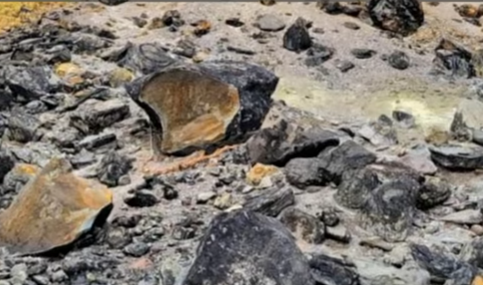Ancient Japanese ‘killing stone’ said to contain evil fox spirit has split in two
Some social media users saw it as bad omen, while others believed it may help bring down Vladimir Putin

Your support helps us to tell the story
From reproductive rights to climate change to Big Tech, The Independent is on the ground when the story is developing. Whether it's investigating the financials of Elon Musk's pro-Trump PAC or producing our latest documentary, 'The A Word', which shines a light on the American women fighting for reproductive rights, we know how important it is to parse out the facts from the messaging.
At such a critical moment in US history, we need reporters on the ground. Your donation allows us to keep sending journalists to speak to both sides of the story.
The Independent is trusted by Americans across the entire political spectrum. And unlike many other quality news outlets, we choose not to lock Americans out of our reporting and analysis with paywalls. We believe quality journalism should be available to everyone, paid for by those who can afford it.
Your support makes all the difference.A slab of volcanic rock linked to the Japanese mythology of a nine-tailed fox split into two last month, sparking dread and fear among locals and on social media.
The stone, known as Sessho-seki, or “killing stone”, was found cracked open in Japan’s Nikko National Park, about 100 miles north of Tokyo.
No one knows how the 6ft-long and 26ft-wide rock cracked, but scientists believe cold temperatures and water seepage may have been responsible.
According to legend, Tamamo-no-Mae, an evil, nine-tailed fox spirit who could transform into a beautiful woman, was trapped in the rock for nearly 900 years. The stone was lethal to humans who dared to approach it, if Japanese folktales are to be believed.
There are multiple stories related to the legend, but the most commonly known story is that of 12th century Japanese emperor, Toba.
The legend says emperor Toba was enchanted by the woman that the fox spirit had turned into. But soon after meeting her, the emperor fell severely ill and a royal astrologer found that the woman was in fact the evil fox spirit.
When the king’s warriors began chasing her, Tamamo-no-Mae is believed to have fled to a forest. She was killed by the warriors’ arrows but her spirit is believed to have been transferred into a stone and trapped inside it.
Nick Kapur, a professor of Japanese history at Rutgers University, shared the story on Twitter after the crack in the stone caused a stir both among locals and on social media.
Some social media users saw it as a bad omen, especially as it came amid an ongoing pandemic and a war in Europe, while others saw it as a positive sign, and believed that the fox spirit may stop Vladimir Putin in Ukraine.
“There’s a kind of millenarian sense in the air, an apocalyptic feeling, with the coronavirus and this war in Ukraine,” Mr Kapur told The New York Times in an interview.
“People are feeling like, ‘Ah, why is all this stuff happening now?’ And so maybe this stone cracking open at this particular time just touches a nerve.”
The stone was a popular tourist attraction. Local stories include tales of the stone killing animals that came near it.
Masaharu Sugawara of a volunteer organisation that provided tourist information in the surrounding area told Japanese newspaper Yomiuri Shimbun:“It’s natural, so it can’t be helped, but it’s a shame because it’s a symbol of the local area.”



Join our commenting forum
Join thought-provoking conversations, follow other Independent readers and see their replies
Comments